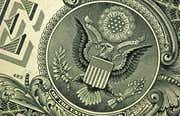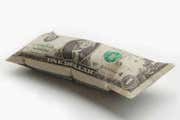|

|
Inflation is also a concern to investors, since changes in inflation and interest rates affect various asset types in different ways. This is an especially important issue for people living on a fixed income, such as retirees.
The impact of inflation on your portfolio depends on the type of securities you hold. If you invest only in stocks, worrying about inflation shouldn't keep you up at night since historically stocks have been quite good hedges against inflation. Over the long run, a company's revenue and earnings should increase at approximately the same pace as inflation, so the prices of stocks should rise along with the general prices of consumer and producer goods. The exception to this is stagflation; the combination of a bad economy with an increase in costs is bad for stocks. Not all companies fare the same with inflation- for example a company with a lot of cash will see the value of that cash decrease with increases in inflation.
The more general problem with stocks and inflation is that a company's returns tend to be overstated. In times of high inflation, a company may look like it's prospering, when really inflation is the reason behind the apparent growth. When analyzing financial statements, it's also important to remember that inflation can wreak havoc on earnings depending on what technique the company is using to value inventory (for example LIFO vs. FIFO).
Fixed-income (i.e. bond) investors are the hardest hit by inflation. Suppose that a year ago you invested $1,000 in a Treasury bill with a 10% yield. Now that you are about to collect the $1,100 owed to you, is your $100 (10%) return the same as $100 a year ago? Of course not. Assuming inflation was positive for the year, your purchasing power has fallen and, therefore, so has your real return. We have to take into account the chunk inflation has taken out of your return. If inflation was 4%, then your net return is really 6%. Remember that inflation benefits borrowers at the expense of lenders: owning a bond is equivalent to being a lender.
This example highlights the difference between nominal interest rates and real interest rates. The nominal interest rate is the growth rate of your money, while the real interest rate is the growth of your purchasing power. In other words, the real rate of interest is the nominal rate reduced by the rate of inflation. In our example, the nominal rate is 10% and the real rate is 6% (10% - 4% = 6%). The terms “real” and “nominal” are also used when talking about changes in GDP, where real GDP accounts for the effects of inflation. Inflation is also accounted for when measuring things in constant dollars – for example, measuring wages in constant 2012 dollars takes out the effects of inflation. As an investor, you must look at your real rate of return. Unfortunately, investors often look only at the nominal return and forget about their purchasing power altogether.
There are a class of bonds that do offer investors the guarantee that returns will not be eaten up by inflation. Treasury inflation-protected securities (TIPS), are a special type of Treasury note or bond. TIPS are like any other government issued bond, except that the principal and coupon payments are tied to the CPI and increase to compensate for any inflation (the actual calculation of price changes and yield on TIPS given changes in inflation can be complicated). TIPS seem like a smart idea, but they have underperformed similar assets over the past decade. Inflation has been so low in recent years that it hasn't been much of an issue and they’ve offered an extremely low rate of return.
Commodities can benefit or lose out to inflation depending on the specific type of commodity. Gold and other precious metals have long been considered a good hedge against inflation, rising in value as the dollar falls. On the other hand, consumable or perishable commodities such as wheat, livestock, or oil tend to do poorly for investors and are not effective hedges against inflation.
Inflation: Conclusion
-
 Trading
TradingCoping With Inflation Risk
Inflation is less dramatic than a crash, but it can be more devastating to your portfolio. -
 Insights
InsightsA Primer On Inflation
Inflation has a negative connotation, but is it all bad or does it offer some tangible benefits? -
 Insights
InsightsHow Inflation Affects Your Net Worth
When calculating your net worth, don't forget to take inflation into account. -
 Insights
InsightsShould You Worry About the U.S Inflation rate?
Understand how inflation is measured, how U.S. inflation compares to other countries, and if investors should be concerned with rising inflation. -
 Retirement
RetirementHow Inflation Eats Away at Your Retirement
When calculating how much money you need to comfortably retire, it's important to factor in how much inflation can chip away at your savings. -
 Investing
InvestingTimeless Ways To Protect Yourself From Inflation
Inflation is a natural part of modern life, but there are some time-tested ways to inflation-proof your assets. -
 Insights
Insights9 Common Effects of Inflation
Is inflation ever good? If you like your job it is. -
 Financial Advisor
Financial AdvisorAre TIPS a Good Buy Right Now?
TIPS are trading at a big discount making this a good time to get into these instruments for those who believe that inflation is on the horizon.


